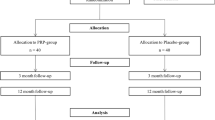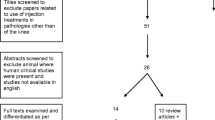Abstract
Biological materials used to assist in haemostasis following total knee arthroplasty have been the subject of much recent research. Autologous platelet gel is a substance that is derived from platelet-rich plasma extracted from the patient's blood and centrifuged perioperatively, and is applied to exposed tissues, synovium and the lining of the wound at closure. Concentrating and applying these factors directly to the wound at the end of a total knee arthroplasty procedure may lead to more complete haemostasis, a reduction in perioperative blood loss, accelerated tissue repair and decreased postoperative pain. In this study, 98 unilateral total knee arthroplasties were evaluated retrospectively, 61 of which involved the intaroperative use of platelet gel, and 37 of which served as control subjects. Outcomes analysed were postoperative haemoglobin changes, intravenous and oral narcotic requirements, range of motion on discharge and total days in hospital. Patients receiving platelet gel during surgery had less postoperative blood loss as measured by differences in the preoperative and postoperative haemoglobin on day 3 (2.7 vs. 3.2 g/dl; P=0.026). The narcotic requirement was less in the platelet gel group for both intravenous (17.0 vs. 36.3 mg/day; P=0.024) and oral (1.84 vs. 2.75 tabs/day; P=0.063) medication. This group also achieved a higher range of motion prior to discharge (78.2 vs. 71.9; P=0.052) and were discharged an average of 1 day earlier than their control counterparts. Though further prospective trials are necessary, this study indicates that the application of autologous platelet gel may lead to improved haemostasis, better pain control and a shortened hospital stay.
Résumé
Le gel de plaquettes autologues est une substance dérivée des plaquettes plasmatiques extraites du sang du patient et centrifugées dans la période péri-opératoire, destiné à être appliquée sur les tissus exposés , la synoviale, et la ligne d’incision à la fermeture. Le but est d’avoir une meilleure hémostase, une réduction de la perte sanguine, une accélération de la réparation tissulaire et une diminution des douleurs post-opératoires. Dans cette étude 98 arthroplasties totales de genou ont été évaluées rétrospectivement, avec utilisation du gel plaquettaire dans 61 cas, les 37 autres servant de groupe témoin. Les éléments étudiés étaient le taux d’hémoglobine, la prise orale ou intraveineuse d’antalgiques et la durée d’hospitalisation. Les patients recevant le gel avaient moins de perte sanguine, mesurée sur le taux d’hémoglobine pré-opératoire et au 3eme jour ( 2,7 vs 3,2 g/dl; P=0,026). La nécessité d’antalgiques était moindre dans le groupe avec gel tant par vois orale (1,84 vs. 2,75 tabs/j; P=0,063) que par voie veineuse (17,0 vs. 36,3 mg/j; P=0,024). Le groupe avec gel atteignait une meilleure amplitude avant le départ (78,2° vs 71,9°; P=0,052) et celui-ci se situait en moyenne un jour plus tôt que dans l’autre groupe. Bien que des essais prospectifs restent nécessaires, l’application du gel plaquettaire semble pouvoir améliorer l’hémostase, le contrôle de la douleur et raccourcir la durée d’hospitalisation.
Similar content being viewed by others

References
Ecker ML, Lotke PA (1993) Wound healing complications. In: Rand JA (ed) Total knee arthroplasty. Raven Press, New York
Bengston S, Knutson K, Lidgren L (1989) Treatment of infected knee arthroplasty. Clin Orthop Relat Res 173–178
Dennis DA (1997) Wound complications in total knee arthroplasty. Instr Course Lect 46:165–169
Insall J, Aglietti P (1980) A 5- to 7-year follow-up of unicondylar arthroplasty. J Bone Joint Surg Am 62:1329–1337
Weiss AP, Krackow KA (1993) Persistent wound drainage after primary total knee arthroplasty. J Arthroplast 8:285–289
Berman AT, Geissele AE, Bosacco SJ (1988) Blood loss with total knee arthroplasty. Clin Orthop Relat Res 137–138
Lotke PA, Faralli VJ, Orenstein EM, Ecker ML (1991) Blood loss after total knee replacement. Effects of tourniquet release and continuous passive motion. J Bone Joint Surg Am 73:1037–1040
Mylod AG Jr, France MP, Muser DE, Parsons JR (1990) Perioperative blood loss associated with total knee arthroplasty. A comparison of procedures performed with and without cementing. J Bone Joint Surg Am 72:1010–1012
Levy O, Martinowitz U, Oran A, Tauber C, Horoszowski H (1999) The use of fibrin tissue adhesive to reduce blood loss and the need for blood transfusion after total knee arthroplasty. A prospective, randomized, multicenter study. J Bone Joint Surg Am 81:1580–1588
Birkmeyer JD, Goodnough LT, AuBuchon JP, Noordsij PG, Littenberg B (1993) The cost-effectiveness of preoperative autologous blood donation for total hip and knee replacement. Transfusion 33:544–551
Etchason J, Petz L, Keeler E et al (1995) The cost effectiveness of preoperative autologous blood donations. N Engl J Med 332:719–724
Hersekli MA, Akpinar S, Ozkoc G et al (2004) The timing of tourniquet release and its influence on blood loss after total knee arthroplasty. Int Orthop 28:138–141
Jorn LP, Lindstrand A, Toksvig-Larsen S (1999) Tourniquet release for haemostasis increases bleeding. A randomized study of 77 knee replacements. Acta Orthop Scand 70:265–267
Christodoulou AG, Ploumis AL, Terzidis IP et al (2004) The role of timing of tourniquet release and cementing on perioperative blood loss in total knee replacement. Knee 11:313–317
Ryu J, Sakamoto A, Honda T, Saito S (1997) The postoperative drain-clamping method for haemostasis in total knee arthroplasty. Reducing postoperative bleeding in total knee arthroplasty. Bull Hosp Joint Dis 56:251–254
Wang GJ, Hungerford DS, Savory CG et al (2001) Use of fibrin sealant to reduce bloody drainage and haemoglobin loss after total knee arthroplasty: a brief note on a randomized prospective trial. J Bone Joint Surg Am 83-A:1503–1505
Akizuki S, Yasukawa Y, Takizawa T (1997) A new method of haemostasis for cementless total knee arthroplasty. Bull Hosp Joint Dis 56:222–224
Mo X, Iwata H, Matsuda S, Ikada Y (2000) Soft tissue adhesive composed of modified gelatin and polysaccharides. J Biomater Sci Polym Ed 11:341–351
Hino M, Ishiko O, Honda KI et al (2000) Transmission of symptomatic parvovirus B19 infection by fibrin sealant used during surgery. Br J Haematol 108:194–195
Jackson MR (2001) Fibrin sealants in surgical practice: an overview. Am J Surg 182:1S–7S
Kawamura M, Sawafuji M, Watanabe M, Horinouchi H, Kobayashi K (2002) Frequency of transmission of human parvovirus B19 infection by fibrin sealant used during thoracic surgery. Ann Thorac Surg 73:1000–1098
Hosgood G (1993) Wound healing. The role of platelet-derived growth factor and transforming growth factor beta. Vet Surg 22:490–495
Knighton DR, Hunt TK, Thakral KK, Goodson WH 3rd (1982) Role of platelets and fibrin in the healing sequence: an in vivo study of angiogenesis and collagen synthesis. Ann Surg 196:379–388
Sanchez AR, Sheridan PJ, Kupp LI (2003) Is platelet-rich plasma the perfect enhancement factor? A current review. Int J Oral Maxillofac Implants 18:93–103
Mustoe TA, Pierce GF, Morishima C, Deuel TF (1991) Growth factor-induced acceleration of tissue repair through direct and inductive activities in a rabbit dermal ulcer model. J Clin Invest 87:694–703
Marx RE, Carlson ER, Eichstaedt RM et al (1998) Platelet-rich plasma: growth factor enhancement for bone grafts. Oral Surg Oral Med Oral Pathol Oral Radiol Endod 85:638–646
Anitua E (2001) The use of plasma-rich growth factors (PRGF) in oral surgery. Pract Proced Aesthet Dent 13:487–893; quiz 487–493
Author information
Authors and Affiliations
Corresponding author
Rights and permissions
About this article
Cite this article
Gardner, M.J., Demetrakopoulos, D., Klepchick, P.R. et al. The efficacy of autologous platelet gel in pain control and blood loss in total knee arthroplasty. International Orthopaedics (SICOT) 31, 309–313 (2007). https://doi.org/10.1007/s00264-006-0174-z
Received:
Revised:
Accepted:
Published:
Issue Date:
DOI: https://doi.org/10.1007/s00264-006-0174-z



